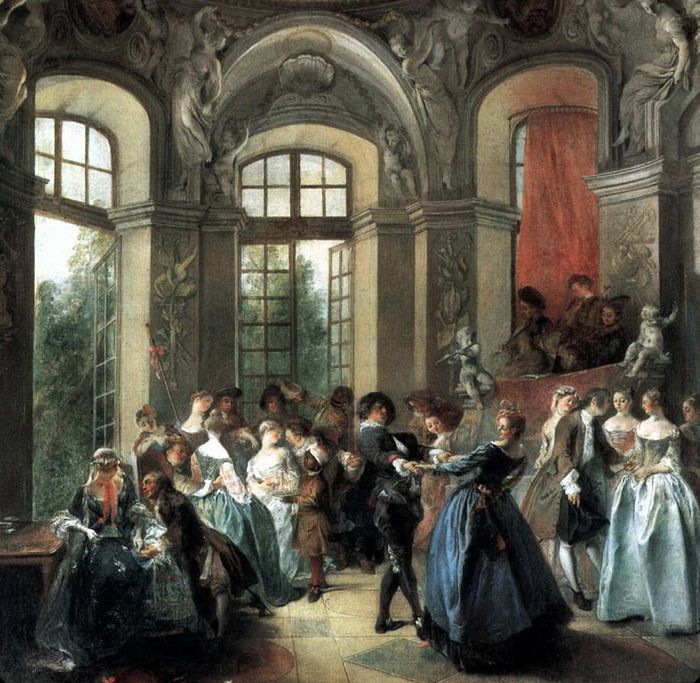
Painting by French artist Nicolas Lancre “Dancing in the pavilion”. The size of the painting is 130 x 97 cm, oil on canvas. Beginning in 1715, public dance evenings and balls were held in famous buildings and palaces in Paris, and the royal decree gave the middle-class people the opportunity, for a certain fee, to take part in these ones dedicated exclusively to dancing and amusements.
Pavilion – in the architecture of a small, isolated amusement house or gazebo in the garden or park, usually having a round or quadrangular shape. The French use this word, moreover, to designate parts of a more or less extensive building, if these parts have the appearance of separate buildings, round or square in plan, adjacent to the building from the sides or occupying its center, such as the Pavilions of the Tulleri Palace in Paris. The Tullera or Tuileries is a palace that existed in Paris on the right bank of the river Seine, with its main facade facing the extensive garden of the same name. extending to Place de la Concorde.
It consisted of three pavilions interconnected by less high, in comparison with them, buildings: from the middle pavilion, called the “Pavilion of the Clock” and and from two side pavilions – the Marsan Pavilion and the Flora Pavilion. The Tulleri Palace began to be built by Queen Catherine de Medici; the builders were the architects Philibert Delorme and Bulyan. Initially, the palace consisted only of the middle pavilion and two short side wings; the remaining units were attached to him under Henry IV, Louis XIII and Louis XIV. The interior of the palace, restored by architects Persier and Fontaine under Napoleon I, Louis-Philippe and Napoleon III, was distinguished by its excellent location of apartments and the luxury of decoration.
The garden adjoining Tulleri was built in 1600 and then in 1655 was beautifully planned by the famous garden architect Louis XIV Lenotrom in French taste, with terraces, large straight avenues, flower gardens, water pools, fountains, etc. Napoleon I decorated this garden even more and surrounded by a magnificent lattice. The garden, adjacent to Tulle, was one of the most attractive places for walking the Parisians and their children’s games.
 Dancing by the Fountain by Nicola Lancre
Dancing by the Fountain by Nicola Lancre Danser dans le pavillon – Nicola Lancre
Danser dans le pavillon – Nicola Lancre Garden Society by Nicola Lancre
Garden Society by Nicola Lancre Pabellón de baile – Nicola Lancre
Pabellón de baile – Nicola Lancre Lady and gentleman with two girls in the garden by Nicola Lancre
Lady and gentleman with two girls in the garden by Nicola Lancre Self Portrait by Nicola Lancre
Self Portrait by Nicola Lancre Winter by Nicola Lancre
Winter by Nicola Lancre Concert in the park by Nicola Lancre
Concert in the park by Nicola Lancre